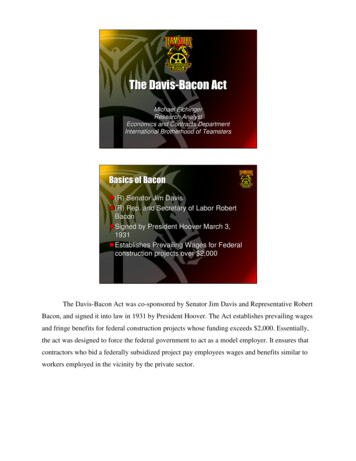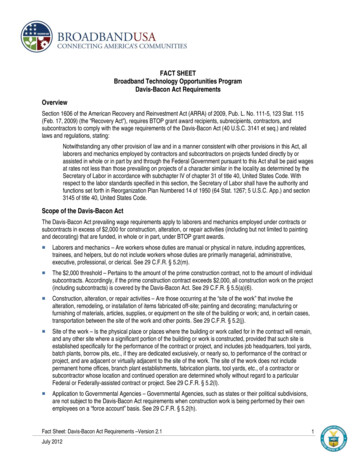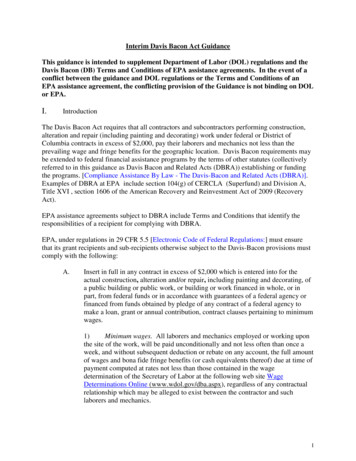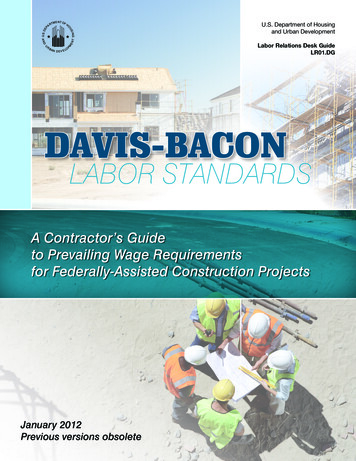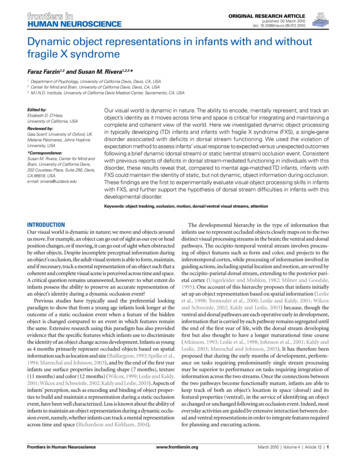
Transcription
Davis-Bacon Act Policies andProceduresState of Nebraska CDBG-DR ProgramJANUARY 2022
RECORD OF CHANGESThe following table summarizes amendments to the Davis-Bacon Policies and Procedures (P&P).Date ChangeApprovedChangeNumberDescription of Change1
TABLE OF CONTENTSRECORD OF CHANGES . 11POLICY OVERVIEW . 41.1ASSOCIATED ALLOCATION(S) . 42ACRONYMS . 53DEFINITIONS . 64SCOPE . 75DAVIS-BACON ACT POLICY . 86785.1OVERVIEW . 85.2IMPLEMENTING AUTHORITIES . 105.3ADDITIONAL FEDERAL REQUIREMENTS. 11ROLES AND RESPONSIBILITIES . 126.1DED . 126.2SUBRECIPIENTS AND SUCCESSFUL APPLICANTS . 146.3CONTRACTORS . 16BIDDING AND CONTRACTING . 177.1OUTREACH . 177.2WAGE RATE DECISIONS . 177.2.1GENERAL WAGE DECISION . 187.2.2PROJECT WAGE DECISION. 187.2.3ADDITIONAL CLASSIFICATION REQUEST PROCESS. 18PRE-CONSTRUCTION PROCEDURES . 208.1PRE-CONSTRUCTION CONFERENCE . 208.2NOTICE TO PROCEED . 222
9MONITORING DURING CONSTRUCTION . 229.1PAYROLL REVIEW . 229.2ON-SITE INTERVIEWS . 2310 REVIEW PRIOR TO PAYMENT . 2610.1PROGRESS PAYMENT . 2610.2FINAL PAYMENT . 2611 RESTITUTION FOR UNDERPAYMENT OF WAGES . 2711.1LIQUIDATED DAMAGES . 2811.1.1ASSESSING LIQUIDATED DAMAGES . 2811.1.2PROCESSING LIQUIDATED DAMAGES . 2911.1.3DETERMINATION OR WAIVER PROCESS . 2911.1.4PAYMENT PROCESS . 3112 FORCE ACCOUNT LABOR . 3112.1LABOR AND EQUIPMENT REQUIREMENTS FOR FORCE ACCOUNT LABOR . 3213 DOCUMENTATION AND REPORTING . 3213.1DOCUMENTATION . 3213.2FORCE ACCOUNT RECORDKEEPING . 3313.3MONITORING . 3413.4CERTIFIED PAYROLL REPORT (CPRS) . 3513.4.113.5COMMON ERRORS AND CORRECTIONS . 35SEMI-ANNUAL REPORTING . 3714 APPENDIX LIST. 373
1 POLICY OVERVIEWThe State of Nebraska’s Department of Economic Development (DED) is responsible for ensuringcompliance with the Davis-Bacon Act, Contract Work Hours and Safety Standards Act(CWHSSA), Fair Labor Standards Act (FLSA), and the Copeland (Anti-Kickback) Act, as well asRelated Acts imposing Davis-Bacon wage and reporting requirements (i.e., Davis-Bacon andRelated Acts or DBRA), across all construction contractors and subcontractors performingconstruction, alteration, or repair (including painting or decorating) of public buildings or publicworks for federally funded or assisted contracts using Community Development Block Grant –Disaster Recovery (CDBG-DR) funds.Pursuant to Federal and State regulations, this P&P addresses Subrecipient and SuccessfulApplicant responsibilities for ensuring compliance with labor regulations, including: Bidding and contract requirements to comply with the United States (US) Department ofHousing and Urban Development (HUD) standards; Enforcement of DBRA, CWHSSA, FLSA, and the Copeland Act’s requirements duringproject implementation; Restitution for underpayment of wages and non-compliance with DBRA; and Documentation and reporting processes to demonstrate compliance.The State of Nebraska enforces conduct of the CDBG-DR program to ensure that no person isexcluded from participation in, denied the benefit of, or subjected to discrimination in any housingprogram or activity because of their age, race, color, creed, religion, familial status, national origin,sexual orientation, military status, sex, disability, or marital status.1.1 ASSOCIATED ALLOCATION(S)Winter Storm Ulmer (DR-4420)oIn early 2019, the State of Nebraska suffered record-breaking damage from severewinter weather, straight-line winds, and its worst flooding event in 50 years, leadingto a federal major disaster declaration (DR-4420) under the Stafford Act. Damagefrom DR-4420 was widespread, leading to disaster declarations in 84 of the State’s93 counties (and four [4] tribal areas), with the worst damage located in the easternpart of the state.oHUD Most Impacted and Distressed (MID) is detailed in the Action Plan andincludes Dodge, Douglas, and Sarpy counties.oA minimum of 80% of this allocation must be invested in HUD-defined MID areas.oA minimum of 70% of total CDBG-DR program funds must be spent on Low- toModerate Income (LMI) populations.4
This subsection may be updated should other allocations become available due to subsequentdisaster events or supplemental allocations.2 ACRONYMSAcronymCDBG-DRMeaningCommunity Development Block Grant – Disaster RecoveryCFRCode of Federal RegulationsCPRCertified Payroll ReportCWHSSADBRAContract Work Hours and Safety Standards ActDavis-Bacon and Related ActsDEDNebraska Department of Economic DevelopmentDOLDepartment of LaborFLSAFair Labor Standards ActFRHCDAFederal RegisterHousing and Community Development Act of 1974HUBHistorically Underutilized BusinessHUDDepartment of Housing and Urban DevelopmentIFBInvitation for BidsLSCOLabor Standards Compliance OfficerLSOLabor Standards OfficerP&PPolicy and ProcedurePOPurchase OrderQPRQuarterly Performance ReportPWPrevailing WageRAPRegistered Apprenticeship ProgramRFPRequest for ProposalSOWStatement of WorkSRASubrecipient Agreement5
AcronymUSUSCMeaningUnited StatesUnited States Code3 DEFINITIONSControlling definitions are found in the CDBG-DR Program Definitions. Key definitionsspecifically relating to this P&P are stated below.Apprentice: A person employed and individually registered in a bona fide apprenticeshipprogram, including Step-Up apprenticeship programs designed for Davis-Bacon constructionwork.1Construction, Prosecution, Completion, or Repair: All types of work done on a particularbuilding or work at the site thereof, including, without limitation, altering, remodeling, painting anddecorating, the transporting of materials and supplies to or from the building or work by theemployees of the construction contractor or construction subcontractor, and the manufacturing orfurnishing of materials, articles, supplies, or equipment on the site of the building or work, bypersons employed at the site by the contractor or subcontractor.2Employed: Every person performing the duties of a laborer or mechanic in the construction,prosecution, completion, or repair of a public building or public work, or building or work financedin whole or in part by loans, grants, or guarantees from the US is employed regardless of anycontractual relationship alleged to exist between the contractor and such person.3Force Account Labor: Labor employed directly by the Grantee (i.e., DED) or Subrecipient oneither a permanent or temporary basis. The workforce can be external (employees hired in theprivate market) or internal (currently employed maintenance or other staff). In essence, the hiringentity obtains the materials and equipment needed and directly employs workers to undertake theimprovement acting as its own general contractor.Labor Standards Compliance Officer (LSCO): The LSCO is a DED managed position that isresponsible for tracking records and monitoring compliance of Subrecipients and SuccessfulApplicants with the requirements described in this P&P.“Davis-Bacon Compliance Principles and Reporting Requirements” Handbook 1344.1 Rev 2 (c). .PDF.229 CFR § 3.2(b).329 CFR § 5.2(o).16
Labor Standards Officer (LSO): The LSO is a Subrecipient or Successful Applicant managedposition that is responsible for the regulatory administration and enforcement of the Federal laborstandards provisions on all SRAs and funding agreements covered by DBRA requirements.Laborer or Mechanic: Includes at least those workers whose duties are manual or physical innature (including those workers who use tools or who are performing the work of a trade), asdistinguished from mental or managerial. The term laborer or mechanic includes apprentices,trainees, helpers, and, in the case of contracts subject to the CWHSSA, watchmen or guards.The term does not apply to workers whose duties are primarily administrative, executive, orclerical, rather than manual.4Prevailing Wages: The minimum wages shall be based on the wages the Secretary of Labordetermines to be prevailing for the corresponding classes of laborers and mechanics employedon projects of a character similar to the contract work in the civil subdivision of the State in whichthe work is to be performed, or in the District of Columbia if the work is to be performed there.5Public Building or Public Work: Building or work for whose construction, prosecution,completion, or repair, as defined above, a Federal agency is a contracting party, regardless ofwhether title thereof is in a Federal agency.6Successful Applicant: Successful Applicants include any eligible entity that is selected to enterinto a funding agreement with DED to implement CDBG-DR program activities (e.g., for-profitdevelopers).Trainee: A person registered and receiving on-the-job training in a construction occupation undera program which has been approved in advance by the DOL, Employment and TrainingAdministration, as meeting its standards for on-the-job training programs and which has been socertified by that Administration.74 SCOPEThese policies and procedures apply to all DED employees, providers, vendors, contractors,consultants, Subrecipients, partners, citizens, Successful Applicants, external departments, andagencies doing business with DED, as well as beneficiaries and others associated with, workingfor, accessing, or attempting to access benefits under the CDBG-DR programs.429 CFR § 5.2(m).The Davis-Bacon Act, as Amended (April 2009). PL 107-217-Section 3142(b).629 CFR § 3.2(c).729 CFR § 5.2(n).57
5 DAVIS-BACON ACT POLICY5.1OVERVIEWThe Davis-Bacon Act (40 USC 3141, et seq., as implemented by 29 CFR Part 5) provides that alllaborers and mechanics employed by contractors or subcontractors in the performance ofconstruction work financed in whole or in part with Federal funds shall be paid wages at rates notless than those prevailing on similar construction in the locality as determined by the Secretary ofLabor. An overview of the steps for Subrecipients and Successful Applicants to carry out DavisBacon requirements is provided in Figure 1.Figure 1: Davis-Bacon Compliance OverviewDesignate a LaborStandards Officer.Determine theEffective WageDecisions.Verify WageDecisions.Provide AdditionalClassification.Conduct a PreConstructionConference(optional).Notify Vendors ofSubcontractorAwards.Section 110 of the Housing and Community Development Act of 1974 (HCDA) applies the DavisBacon Act to components of the CDBG program, including CDBG-DR, and, as a result, the HCDAis a “Related Act” for purposes of the Davis-Bacon Act. To determine if Davis-Bacon is applicableto a specific project activity, see Appendix A: Davis-Bacon Project Applicability Cheat Sheet.Construction contracts in excess of 2,000 awarded by DED under the CDBG-DR program shallinclude a provision for compliance with Davis-Bacon and associated DOL and HUD regulations.The principal requirements are: Subrecipients and Successful Applicants must include a copy of the current PrevailingWage (PW) rate decision in each Invitation For Bid (IFB), Request For Proposal (RFP),and Purchase Order (PO) when applicable; Subrecipients and Successful Applicants may only award contracts to eligible contractorsand subcontractors who have accepted the wage rate decision and have signed acertification to pay wages on that basis and who will comply with other labor standards;8
Contractors must pay laborers the wage rate that DOL determines is the PW in that labormarket; Contractors must submit weekly payrolls; and Subrecipients and Successful Applicants are required to report all suspected, reported, orconfirmed violations to DED.A wage decision will state the minimum hourly pay and fringe benefits that must be paid to specificclasses of workers such as carpenters, electricians, and backhoe operators. If a worker(s) will beemployed to work on the project but is part of a particular class of laborers that is not listed in thewage decision, the contractor must request an additional classification. The steps to complete anadditional classification are summarized below in Figure 2 (see also section 7.2, Wage RateDecisions).Figure 2: Steps to Complete an Additional ClassificationStep 1: PrimeContractorRequests an additional classification and rate by notifying theSubrecipient, Successful Applicant, or DED (as applicable) of theadditional classification and rate being requested.Step 2: SuccessfulApplicant orSubrecipientAdvises the prime contractor regarding wage rates to be requested.Step 3: SuccessfulApplicant orSubrecipientPrepares and submits a Request for Authorization of AdditionalClassification and Rate (per section 7.2, Wage Rate Decisions) andrelevant supporting documentation to DED.Step 4: DEDReviews and completes the Report and sends the form and supportingdocumentation, if any, to the DOL.Step 5: DOLResponds by approving the requested rate and sending DED an officialresponse to the contractor’s request.Step 6: DEDForwards the DOL response to the Successful Applicant orSubrecipient (as applicable).Step 7: SuccessfulApplicant orSubrecipientNotifies the prime contractor of the results of the DOL response. Theprime contractor is responsible for sharing the response with anysubcontractors, as applicable.9
HUD has published a contractor’s guide to PW requirements for federally assisted constructionprojects. Subrecipients and Successful Applicants may use this “Making Davis-Bacon Work”guidebook to obtain a better understanding of Davis-Bacon laws and regulations and to determinehow to comply with these laws and regulations.8All Subrecipients and Successful Applicants must follow HUD and DOL reporting requirements.DED will monitor and enforce completion of the following reports: Weekly Statement of Compliance (a.k.a. a Certified Payroll Report [CPR]) that certifiescompliance with DBRA requirements (see Optional Form WH-347); Report of any violations that occurred that week; and Reports must be kept by each contractor or subcontractor for at least three (3) years.HUD also requires quarterly performance reports (QPRs) from DED in addition to the CPRs thatSubrecipients and Successful Applicants send to DOL via DED. DED will use informationgenerated from standard quarterly program reporting generated by Subrecipients and SuccessfulApplicants to complete QPRs to HUD (for further details, see Monitoring and Compliance Plan).5.2IMPLEMENTING AUTHORITIESDED will have an established Labor Standards Compliance Officer (LSCO) to manage monitoringand compliance for all Subrecipients and Successful Applicants funded through the CDBG-DRprogram. Subrecipients and Successful Applicants are required to appoint and maintain a LaborStandards Officer (LSO) for all SRAs and funding agreements involving construction activities.LSOs are appointed using the DED Appointment of Labor Standards Officer Designation Form(see Appendix B: Appointment of Labor Standards Officer Form Template) as submitted toDED. The LSO may be an employee of a Subrecipient or Successful Applicant or may be a thirdparty retained for the purpose. The primary qualification of an LSO is an understanding of HUD’soverall compliance requirements with the Federal PW obligations applicable to HUD-fundedCDBG programs and regular attendance at HUD and DOL trainings.The LSOs are responsible for the regulatory administration and enforcement of the Federal laborstandards provisions on all SRAs and funding agreements covered by DBRA requirements.These activities will be conducted with support from DED’s LSCO.8The guidebook is located at: requirements/.10
5.3ADDITIONAL FEDERAL REQUIREMENTSThis P&P is structured to ensure compliance with Federal wage and labor relations statutes andregulations applicable to Grantees (i.e., DED), Subrecipients, and Successful Applicants ofCDBG-DR funds, including the following: Davis-Bacon and Related Acts, as described above in section 5.1, Overview; The Copeland Act (18 USC 874 and 40 USC 3145, as implemented in 29 CFR Part 3)“applies to any contract which is subject to Federal wage standards” to ensure that anyperson working on a federally funded or assisted construction project is not forced to “giveup any part of compensation to which he is entitled under his employment contract.”9 The CWHSSA (40 USC 3701 et seq., as implemented in 29 CFR Part 5) requires thatcontracting officers ensure compliance of “any contract in an amount in excess of 100,000 and subject to the overtime provisions,” including associated requirementsincluding liability for unpaid wages, withholding for unpaid wages and liquidated damages,and the applicability of such rules to subcontracts.10 The FLSA (29 USC § 201) establishes standards for employment and employee pay bybusiness organizations and is especially applicable to construction activities. A businessin the construction industry must have two (2) or more employees and have an annualgross sales volume of 500,000 or more to be subject to the FLSA. Individual coverageapplies to employees whose work regularly involves them in commerce between thestates (“interstate commerce”).11Exceptions to DBRA, CWHSSA, FLSA, and the Copeland Act include:12 Construction contracts at or below 2,000. Note that arbitrarily separating a project intoindividual contracts below 2,000 in order to circumvent Federal requirements is notpermitted; Rehabilitation or construction of residential properties containing seven (7) or fewer units(single-family homeowner properties are typically excluded from DBRA compliancerequirements);929 FR 97.48 FR 19540.11Any person who works on or otherwise handles goods that are moving in interstate commerce or whoworks on the expansion of existing facilities of commerce is individually subject to the protection of theFLSA and the current minimum wage and overtime pay requirements, regardless of the sales volume ofthe employer.12HUD, 2013. “HUD Handbook 1344.1, Federal Labor Standards Requirements in Housing and UrbanDevelopment Programs.” See ork-ScheduleRequest.pdf.1011
oIf the residential property has eight (8) or more units, DBRA compliance may beapplicable. For example: Five (5) side-by-side townhouses consisting of two (2) units each. Three (3) apartment buildings each with five (5) units located on one (1)tract. Eight (8) single-family (not homeownership) houses located on contiguouslots. Simple water and sewer line extensions without pumps, tanks, etc.; Contracts solely for demolition when no federally funded construction is anticipated on thesite; and Wage requirements shall not apply to any individual who:oPerforms services for which the individual volunteered;oDoes not receive compensation for such services;oIs paid expenses, reasonable benefits, or a nominal fee for such services; oroIs not otherwise employed at any time in the construction work.All construction contractors (including CDBG-DR-funded construction contracts where specialconditions or permits apply due to the specific project description or location) are required tocomply with DBRA.6 ROLES AND RESPONSIBILITIES6.1DEDAs the Grantee, DED is responsible for overseeing and monitoring Subrecipients and SuccessfulApplicants for compliance with DBRA and submitting QPRs to HUD through DRGR. DED willrequire Subrecipients and Successful Applicants using CDBG-DR funds to adopt these policiesand procedures and to include labor standards and wage determination clauses in all constructioncontracts subject to labor standard provisions. DED shall establish an LSCO to managemonitoring and compliance for all Subrecipients and Successful Applicants.The LSCO acts as DED’s liaison for possible labor standard and compliance issues andcompletes the following, but not limited to, activities: Confirming the specific labor standards provisions applicable to the project (e.g., DavisBacon wage and reporting requirements, CWHSSA, Copeland Act, FLSA) andcommunicating such requirements to Subrecipients and Successful Applicants;12
Processing additional classification requests and reconsidering them when necessary, asdescribed in section 5.1, Overview, and section 7.2.3, Additional ClassificationRequest Process; Documenting the wage decision before the award of the contract using the CDBG-DRImplementation Manual for verification and maintaining the form in DED’s labor files; Receiving notification from the Subrecipient or Successful Applicant before a contractorbegins to work on a project; Signing off on contractor clearance; Creating and submitting the semi-annual report; Maintaining contact with HUD’s Regional Labor Enforcement as necessary to determineassistance or support on decisions; Providing training and technical assistance to Subrecipient and Successful ApplicantLSOs; Maintaining P&P such as the current document, forms, and records that demonstrateSubrecipients, Successful Applicants, and contractors are informed or have been providedtechnical assistance regarding labor standards; Ensuring compliance with requirements by performing periodic “spot-check” reviews ofcertified payroll submissions and related submissions, including comparison of on-siteinterview data against CPRs for compliance with the labor standards and requestingadditional information when needed or rejecting submitted payrolls as needed; Enforcing the referral of potential criminal/complex investigations, debarment, orCWHSSA liquidated damages to HUD by providing HUD with a summary of the findings,schedule of back wages due, issued notices to the contractor, and notice of intent toassess liquidated damages and implementing the final order of liquidated damages; Receiving and transmitting labor standard enforcement reports (“Enforcement Reports”)from Subrecipients and Successful Applicants to provide to DOL; Identifying potential willful violations through spot-check reviews or employee interviewsand following up on potential willful violations through employee questionnaires and othertechniques to identify cases for investigation; and Enforcing corrective actions for identified errors including, but not limited to:oMisclassification of laborers and mechanics;oIf the actual pay is less than full PW, including fringe benefits for all hours worked(including overtime);oCopy or Fax Statement of Compliance (a.k.a. CPR);13
oInadequate recordkeeping, such as not counting all hours worked by an individualor not recording hours worked in two (2) or more classifications in one (1) day;oIncomplete Payroll Information;oFailure to submit weekly payrolls – including for weeks of no work;13oOne (1) Statement of Compliance (a.k.a. CPR) for multiple work weeks;oOther deduction authorizations not completed;oUnauthorized signature on Statement of Compliance (a.k.a. CPR); andoApprenticeships or trainees not properly documented.The LSCO will also oversee the LSOs and support communications between Subrecipient orSuccessful Applicant LSOs and HUD, DOL, or other Federal ch Subrecipient or Successful Applicant shall designate an LSO responsible for trackingrecords and monitoring compliance with the requirements described in this P&P. The activities tobe completed by the LSO include, but are not limited to, the following:1314 Ensuring that the current applicable Davis-Bacon wage decision and contract standardsare incorporated into the contract for construction (e.g., construction specifications); Searching the SAM website14 no more than 10 days prior to a bid opening to ensure thatthe wage decision in the bid package is current and notifying DED of the package’s status; Submitting contractors for clearance to DED receiving approval prior to beginning work ona project; Submitting quarterly reports to DED to inform the semi-annual report; Researching and resolving labor violations; Assessing liquidated damages; Conduct on-site interviews; Setting up wire transfers to liquidated damages and unfound workers;For additional information, see section 13.4, Certified Payroll Report (CPRs).See https://sam.gov/content/wage-determinations.14
Reviewing payrolls for restitution; Resolving special issues; Conducting a pre-construction kickoff conference with prime contractors andsubcontractors (optional); Conducting field inspections at the job site to establish compliance with laborrequirements, including:oEnsuring the wage decision and required posters are posted prominently; andoInterviewing employees to determine payroll accuracy and compliance with DBRArequirements. The LSO must interview prime contractors, subcontracts whosecontract is 100,000 or greater, at least one (1) of every job classification on site,and any subcontractors with a large number of payroll problems. Ensuring that no contract is awarded to any contractor that is debarred or otherwiseineligible to participate in Federal programs by implementing methods for verification ofcontract signing, execution, and updates from other DED programmatic areas; Receiving and transmitting labor standard enforcement reports (“Enforcement Reports”)to DED for transmission to DOL (see Appendix C: Labor Standards EnforcementReport Template). Providing standard quarterly reports for program activities to DED in order to inform QPRreporting to HUD. Communicating to DED the referral potential criminal/complex investigations, debarment,or CWHSSA liquidated damages for routing to HUD by providing DED a summary of thefindings, schedule of back wages due, issued notices to the contractor, and notice of intentto assess liquidated damages and implementing the final order of liquidated damages; Establishing a complaints process and assure worker complaints are addressed promptly; Preparing reports on all enforcement activities; Disposing of deposit/escrow accounts established for labor standards purposes; and Establishing and maintaining full documentation of all labor standards administration andenforcement activities in accordance with section 13, Documentation and Reporting .Details needed for the appointment of an LSO are provided in Appendix B: Appointment ofLabor Standards Officer Form Template.Implementation of the activities described here shall also be the responsibility of any implementingdepartment, contractor, Successful Applicant, or
The Davis-Bacon Act (40 USC 3141, et seq., as implemented by 29 CFR Part 5) provides that all laborers and mechanics employed by contractors or subcontractors in the performance of construction work financed in whole or in part with Federal funds shall be paid wages at rates not less than those prevailing on similar construction in the locality .
